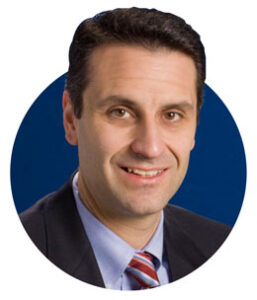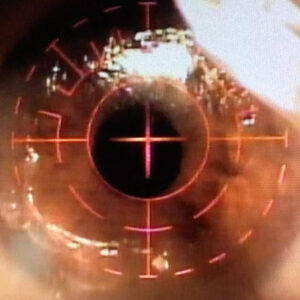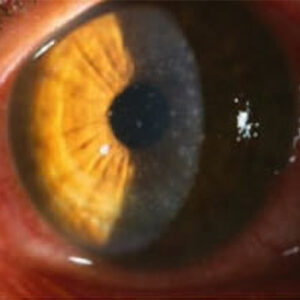ASCRS News: ASCRS/EyeWorld Journal Club
March 2021
by Jennifer Nadelmann, MD, Daniel Choi, MD, Diana Kim, MD, Dario Marangoni, MD, Zujaja Tauqeer, MD, and Paul Tapino, MD

Residency Program Director
Scheie Eye Institute
University of Pennsylvania
Philadelphia, Pennsylvania
The preoperative assessment for patients considering cataract surgery currently includes dilated fundus biomicroscopy in order to identify underlying retinal conditions.1,2 The identification of retinal pathologies in patients considering cataract surgery is essential because it affects surgical planning, clinical decision- making, surgical outcomes, and helps guide the informed consent process and patient expectations.1,2,3 Specifically, cataract surgery candidates with retinal pathologies that are visually significant can be referred to a retinal specialist to determine whether they require treatment for the retinal condition, such as a combined cataract-retinal surgery or intraoperative injection, or stabilization of the retinal pathology prior to proceeding with cataract extraction. In patients with dense lens opacities, the fundus exam may be limited, which may lead to inability to diagnose clinically significant retinal diseases.2 Optical coherence tomography (OCT) is a quick and non-invasive imaging modality that has a high sensitivity in diagnosing macular conditions and is often utilized in patients considering advanced technology intraocular lenses (IOLs).3 The use of SD (spectral-domain) OCT is not currently the standard of care for cataract surgery candidates who are not considering premium IOLs.2

Resident
Scheie Eye Institute
University of Pennsylvania
Philadelphia, Pennsylvania
Summary
The authors reported on a large retrospective case series that took place between November 2017 and January 2018 at the Shaare Zedek Medical Center in Jerusalem, Israel, a large tertiary care center. Patients were included if they had senile cataracts scheduled for cataract extraction, were at least 50 years of age or older, and had a SD-OCT (SPECTRALIS, Heidelberg Engineering) scan prior to surgery. A single retinal specialist reviewed the scans to diagnose macular pathologies and to determine whether patients should be referred to a retinal specialist. The retinal specialist was blinded to the patients’ medical records and exam findings. The OCT interpretation was then compared to the preoperative fundus exam to determine the rate of missed and underestimated macular pathologies. Missed macular pathologies were defined as those that were detected by SD-OCT but not by fundus exam. Underestimated macular pathologies were those that were originally detected by fundus exam but had not been considered clinically significant enough to necessitate further assessment by a retinal specialist prior to obtaining the SD-OCT. The authors also measured factors associated with higher rates of macular pathologies including age, gender, and diabetes mellitus. The authors reviewed changes in management, which they defined as any alteration to the preoperative process as a result of the macular SD-OCT.4
There were 453 eyes originally enrolled in the study, 42 (9.2%) of which were excluded due to having non-interpretable scans because of advanced cataract. Macular pathologies were detected by SD-OCT in 167/411 eyes (40.6%). There were 12 eyes that had more than one condition that was detected on SD-OCT. The most common diseases diagnosed were age-related macular degeneration (AMD) in 50%, epiretinal membrane (ERM) in 28.3%, and cystoid macular edema (CME) in 12.8% of eyes. Of note, patients with macular pathologies were found to be older (77.4 vs. 72.4 years, P<0.01) and had a higher incidence of diabetes mellitus (41.9% vs. 30.3%, P=0.02). Based on the SD-OCT findings, a change in management was undertaken in 107/411 eyes (26%), among whom 94/411 (22.8%) had macular pathologies missed, and 13/411 (3.2%) had pathologies underestimated based on fundus exam alone. Specifically, 73/411 patients (17.8%) were discouraged from presbyopia-correction solutions, and 34/411 patients (8.3%) were referred to a retina specialist. Among the patients who were referred to a retinal specialist, 15/34 proceeded with cataract surgery. Eleven underwent preoperative retinal treatment, four underwent a combined retinal surgery, one had an intraoperative intravitreal injection, and three had their cataract surgery canceled.4

Top: Zujaja Tauqeer, MD
Middle from left: Diana Kim, MD, Jennifer Nadelmann, MD
Bottom from left: Dario Marangoni, MD, Daniel Choi, MD
Source: Scheie Eye Institute
Discussion
This study showed that SD-OCT was more effective than fundus exam in detecting macular pathologies in patients scheduled for cataract surgery. In addition, the detection of subtle macular pathologies on SD-OCT led to a change in patient management in 26% of cases. Previous studies have shown that posterior segment SD-OCT has a greater sensitivity to diagnose macular conditions than exam alone.3,5–11 Studies have also shown that AMD and ERM are the most common pathologies detected by OCT.3,5,10,12 The postoperative visual acuity following cataract surgery is dependent on remaining refractive error, the implanted IOL, and the presence of ophthalmologic pathologies. Therefore, macular pathologies that may be visually significant should be diagnosed prior to cataract surgery to guide patient expectations.1,2
Many of the cataract surgeons on the ASCRS Journal Club panel have been incorporating OCT into their preoperative assessment for at least 3 years. An advantage of obtaining an OCT is that it helps educate patients on the presence of retinal conditions prior to making the decision to undergo cataract surgery. Now more than ever, patients expect to be free of glasses and contact lenses following cataract surgery. An unexpected retinal pathology that limits vision postoperatively can cause patient dissatisfaction and raise concerns that the pathology was missed on exam prior to the surgery or may have been caused by the surgery. Therefore, the panelists thought that it was important to discuss concomitant retinal diseases with patients prior to proceeding with cataract surgery in order to appropriately set expectations and decrease the risk of patient dissatisfaction postoperatively. Especially in patients with mature cataracts, an OCT scan is essential when the view to the fundus is obscured. Some challenges that were mentioned included that some ophthalmologists may not have an OCT capable machine in their office as well as concerns around reimbursement when ordering an OCT without a known diagnosis or indication. In the setting of the current COVID-19 pandemic, the panelists also thought that the use of SD-OCT could enable a more focused examination.
A significant limitation to the use of SD-OCT in routine preoperative cataract surgery screening for retinal pathology is that a dense cataract may itself prove a barrier to obtaining sufficient resolution on a macular scan. In this study, nearly 1 in 10 scans were excluded due to being non-interpretable secondary to advanced cataract. Another limitation of this study is that it did not exclude patients who had previously diagnosed macular pathologies. In addition, the study took place at a large tertiary care center with several older patients with advanced cataracts, many of whom had other concomitant systemic and ophthalmic conditions. Finally, the study did not report on or compare the postoperative visual acuity and change in vision in patients who had macular pathologies caught on SD-OCT compared to those with normal scans.
Leung et al. showed that a preoperative OCT added to the costs of cataract surgery in a patient considering a multifocal IOL but improved the quality-adjusted life years (QALYs) over time by increasing the detection of macular pathologies.13 Further studies are indicated to evaluate the cost effectiveness of the use of macular SD-OCT scans prior to routine cataract surgery.
Conclusion
Overall, this study retrospectively evaluated the utility of macular SD-OCT scans in routine preoperative assessment for cataract surgery. In this study, SD-OCT improved detection of macular pathologies that had been missed or underestimated by fundus exam, leading to clinical management changes prior to cataract surgery with respect to intraocular lens selection as well as retinal consultation. Additional studies are needed to measure the cost effectiveness of obtaining SD-OCT prior to routine cataract surgery.
Patient management modifications in cataract surgery candidates following incorporation of routine preoperative macular OCT
Yishay Weill, MD, Joel Hanhart, MD, David Zadok, MD, David Smadja, MD, Evgeny Gelman, MD,
Adi Abulafia, MD
J Cataract Refract Surg. 2021;47(1):78–82.
- Purpose: To assess the clinical relevance of routine preoperative spectral-domain optical coherence tomography (SD-OCT) for identifying macular pathologies in patients scheduled for cataract surgery.
- Setting: Shaare Zedek Medical Center, Jerusalem, Israel.
- Design: Retrospective case series.
- Methods: Consecutive patients, 50 years of age and older, scheduled for standard cataract extraction surgery were enrolled from November 2017 to January 2018. All study patients underwent routine SD-OCT scanning prior to cataract surgery. The scans were reviewed by a retina specialist for macular pathology and compared to preoperative biomicroscopic fundus examination findings. The incidence of macular pathologies and changes in patient management as a result of the macular SD-OCT findings were assessed.
- Results: Four-hundred and fifty-three eyes of 453 patients were enrolled in the study. Forty-two (9.2%) eyes were excluded due to non-interpretable SD-OCT scans attributable to advanced cataract, leaving scans of 411 eyes of 411 patients for study inclusion. Macular pathologies were detected by SD-OCT in 167 (40.6%) eyes, including age-related macular degeneration (50%), epiretinal membrane (28.3%), and cystoid macular edema (12.8%). Overall, the management of 107 (26.0%) patients was modified due to macular SD-OCT findings, which were either missed (22.8%) or underestimated (3.2%) by the fundus biomicroscopy examination. Changes in preoperative patient management included altering patient consultation regarding presbyopia correction solutions (73 eyes, 17.8%) and referral to a retina specialist for consultation (34 eyes, 8.3%).
- Conclusion: Routine macular SD-OCT scans for cataract surgery candidates help to identify macular pathologies that may be missed or underestimated by standard fundus biomicroscopy examination. The added information can improve patient management.
ARTICLE SIDEBAR
The ASCRS Journal Club is a virtual, complimentary CME offering exclusive to ASCRS members that brings the experience of a lively discussion of two current articles from the Journal of Cataract & Refractive Surgery to the viewer. Co-moderated by Nick Mamalis, MD, and Leela Raju, MD, the January session featured a presentation by Riccardo Vinciguerra, MD, lead author of “Evaluating keratoconus progression prior to crosslinking: Kmax versus the ABCD grading system.” The second manuscript, “Patient management modifications in cataract surgery candidates following incorporation of routine preoperative macular OCT,” was presented by Jennifer Nadelmann, MD, resident, Scheie Eye Institute, University of Pennsylvania. To view the January Journal Club session, visit: https://ascrs.org/clinical-education/journal-club/schedule/january-2021.
References
- McKeague M, et al. Evaluation of the macula prior to cataract surgery. Curr Opin Ophthalmol. 2018;29:4–8.
- Olson RJ, et al. Cataract in the Adult Eye Preferred Practice Pattern. Ophthalmology. 2017;124:P1–119.
- Klein BR, et al. Preoperative macular spectral-domain optical coherence tomography in patients considering advanced-technology intraocular lenses for cataract surgery. J Cataract Refract Surg. 2016;42:537–541.
- Weill Y, et al. Patient management modifications in cataract surgery candidates following incorporation of routine preoperative macular OCT. J Cataract Refract Surg. 2021;47:78–82.
- Abdelmassih Y, et al. Preoperative spectral-domain optical coherence tomography in patients having cataract surgery. J Cataract Refract Surg. 2018;44:610–614.
- Enright NJ, et al. Yield of routine pre-cataract surgery macular optical coherence tomography in finding clinically undetected macular pathology. Clin Exp Ophthalmol. 2017;45:829–831.
- Gallemore RP, et al. Diagnosis of vitreoretinal adhesions in macular disease with optical coherence tomography. Retina. 2000;20:115–120.
- Huang X, et al. Macular assessment of preoperative optical coherence tomography in ageing Chinese undergoing routine cataract surgery. Sci Rep. 2018;8:5103.
- Kowallick A, et al. Optical coherence tomography findings in patients prior to cataract surgery regarded as unremarkable with ophthalmoscopy. PLoS One. 2018;13:e0208980.
- Pinto WP, et al. Prevalence of macular abnormalities identified only by optical coherence tomography in Brazilian patients with cataract. J Cataract Refract Surg. 2019;45:915–918.
- Sudhalkar A, et al. Incorporating optical coherence tomography in the cataract preoperative armamentarium: Additional need or additional burden? Am J Ophthalmol. 2019;198:209–214.
- Zafar S, et al. Swept-source optical coherence tomography to screen for macular pathology in eyes having routine cataract surgery. J Cataract Refract Surg. 2017;43:324–327.
- Leung EH, et al. Cost-effectiveness of preoperative OCT in cataract evaluation for multifocal intraocular lens. Ophthalmology. 2020;127:859–865.
Contact
Nadelmann: Jennifer.Nadelmann@pennmedicine.upenn.edu
Tapino: Paul.Tapino@pennmedicine.upenn.edu



